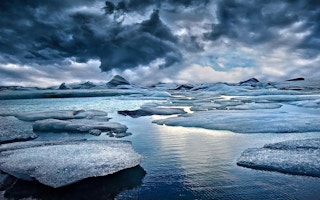The weather will be less stormy over the crowded landscapes of the US, Europe and Asia – and perhaps more cloudy in the high latitudes. Neither forecast is necessarily good news.
US climate scientists have found that cloud formation over the Arctic increases the chance of warming, and could accelerate the melting of the ice caps.
And researchers in Germany have looked at the lower summer storm counts and once again linked them with sustained extremes of heat and drought, or prolonged cold spells.
Both studies are based on the planet’s apparent response to global warming, driven by higher concentrations of greenhouse gases in the atmosphere, released by human combustion of coal, oil and natural gas.
And each is a reminder that the climate’s response to a steady rise in global average temperatures – and these are now 1°C above the average for most of human history – is difficult to predict, and sometimes against intuition.
Cloud heating
Christopher Cox of the US National Oceanic and Atmospheric Administration’s earth system laboratory in Boulder, Colorado and colleagues report in Nature Communications that although the Arctic is already one of the fastest-warming regions on Earth, clouds overhead – which normally reflect sunlight and cool the region below them – could turn up the thermostat.
They looked at the patterns of data from weather stations in Alaska, Canada and Greenland and found that clouds appeared to amplify regional warming.
“As the Arctic atmosphere warms and moistens, it becomes a better insulator. While we expected this to reduce the influence from clouds, which provide additional insulation, we found that clouds forming in the Arctic in these conditions appear to further warm the surface, especially in the fall and winter,” Dr Cox said.
And across the Atlantic, Jascha Lehmann and Dim Coumou of the Potsdam Institute for Climate Impact Research write in the journal Scientific Reports that they studied the link between storm tracks and surface weather extremes.
In 2014 the northeastern US experienced a severe and sustained cold spell, while California stayed stricken by drought. There was drought in China’s northern farmland and severe flooding in the UK.
And they found significant reductions in summer storm activity over as much as 80 per cent of the land area in the mid-latitudes. In winter, the findings were more patchy – but there were pronounced reductions over the eastern US and large parts of Europe and Asia.
The Potsdam scientists have already made a link between storm frequency and extremes, but science works by replication, and confirmatory studies matter. The researchers think the change in pattern could be linked to changes in the jet stream that make some extremes of heat and cold more likely.
“Less of less severe storms in the mid-latitudes, this at first sight seems to be good news – but unfortunately it isn’t,” said Lehmann, a PhD candidate at Potsdam. “These storms have a moderating effect on land temperatures as they bring maritime air from the oceans to the continents, and a lack of them can thus favour extreme temperatures.”
But, as usual, further research is necessary: the scientists think they have established a link. Proving cause and effect is a different matter.
“Our study highlights how sensitive regional weather conditions are to any changes in large-scale atmosphere dynamics,” said Dr Coumou. “This can have serious impacts for people on the ground.”










